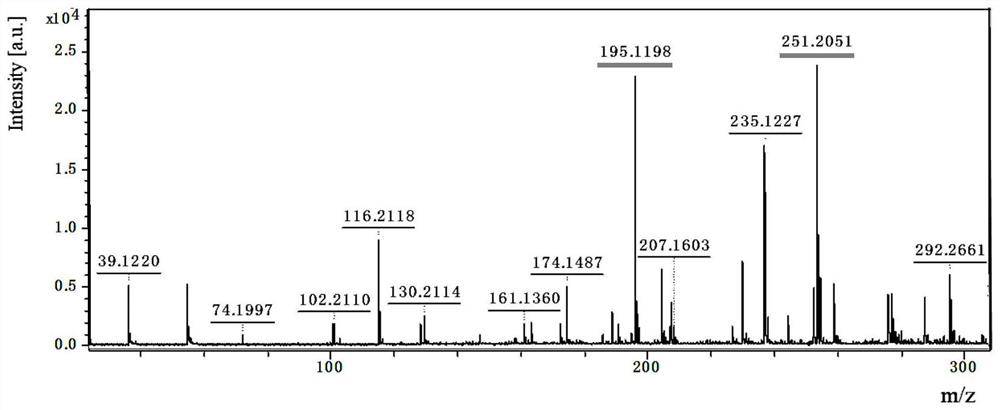A detection method for exogenous organic pollutants in plants
A technology of organic pollutants and detection methods is applied in the field of detection of exogenous organic pollutants in plants, and achieves the effects of efficient and rapid detection, shortened time, and simplified sample pretreatment steps.
- Summary
- Abstract
- Description
- Claims
- Application Information
AI Technical Summary
Problems solved by technology
Method used
Image
Examples
Embodiment 1
[0118] Substrate selection:
[0119] (1) Accurately draw 1 μL of 1-butyl-3-methylimidazole bromide standard solution with a concentration of 1mg / L with a pipette gun, spot the sample on a stainless steel target plate, and wait for it to dry naturally, then use a pipette gun to Accurately draw 1 μL of DHB matrix solution with a concentration of 10g / L, and place it on the air-dried position. Co-crystals are formed under natural drying conditions, and the target plate is put into a mass spectrometer for analysis.
[0120] Mass spectrometry method:
[0121] Positive ion reflection detection mode is applied, the mass range is 0~1000Da, and the sampling rate is 2.0GS / s;
[0122] Using 337nm nitrogen source laser, laser energy 60%, laser frequency 30.0Hz;
[0123] Number of laser clicks: 100 per map;
[0124] Reflector voltage 1800V, ion source acceleration voltage 18kV, ion source vacuum 3.0×10 -6 mbar.
[0125] Other parameters are system default values.
[0126] Thereby obt...
Embodiment 2
[0145] The setting of the blank control group:
[0146] The pea seeds were cultivated in the nutrient solution for 4 weeks, and the obtained pea plants were used as a blank control group.
[0147] 1. Pretreatment of blank samples:
[0148] A pea plant was selected, 1 cm of root tissue was cut off, and sliced by a cryostat. The thickness of the obtained tissue slices was 100 μm. The tissue sections were fixed on an indium tin oxide conductive glass slide, and freeze-dried at a vacuum degree of -0.08MPa at a temperature of -60°C for 24 hours. Then, use the ImagePrep instrument (Bruker Daltonics) to deposit a DCTB matrix solution with a concentration of 10 g / L. The solvent is dichloromethane. The deposition needs to undergo 2 s of spraying, 30 s of incubation and 60 s of drying. After drying, continue to repeat the 2 s process. Spraying, incubation for 30 s and drying for 60 s, the number of repetitions was 59 times to obtain a pretreatment blank sample.
[0149] 2. Mass spe...
Embodiment 3
[0170] The setting of the blank control group:
[0171] The pea seeds were cultivated in the nutrient solution for 4 weeks, and the obtained pea plants were used as a blank control group.
[0172] 1. Pretreatment of blank samples:
[0173] A pea plant was selected, 1 cm of root tissue was cut off, and sliced by a cryostat. The thickness of the obtained tissue slices was 100 μm. The tissue sections were fixed on an indium tin oxide conductive glass slide, and freeze-dried at a vacuum degree of -0.08MPa at a temperature of -70°C for 24 hours. Then, use the ImagePrep instrument (Bruker Daltonics) to deposit a DCTB matrix solution with a concentration of 10 g / L. The solvent is dichloromethane. The deposition needs to undergo 2 s of spraying, 30 s of incubation and 60 s of drying. After drying, continue to repeat the 2 s process. Spraying, incubation for 30 s and drying for 60 s, the number of repetitions was 59 times to obtain a pretreatment blank sample.
[0174] 2. Mass spe...
PUM
| Property | Measurement | Unit |
|---|---|---|
| thickness | aaaaa | aaaaa |
| concentration | aaaaa | aaaaa |
Abstract
Description
Claims
Application Information
 Login to View More
Login to View More - Generate Ideas
- Intellectual Property
- Life Sciences
- Materials
- Tech Scout
- Unparalleled Data Quality
- Higher Quality Content
- 60% Fewer Hallucinations
Browse by: Latest US Patents, China's latest patents, Technical Efficacy Thesaurus, Application Domain, Technology Topic, Popular Technical Reports.
© 2025 PatSnap. All rights reserved.Legal|Privacy policy|Modern Slavery Act Transparency Statement|Sitemap|About US| Contact US: help@patsnap.com



